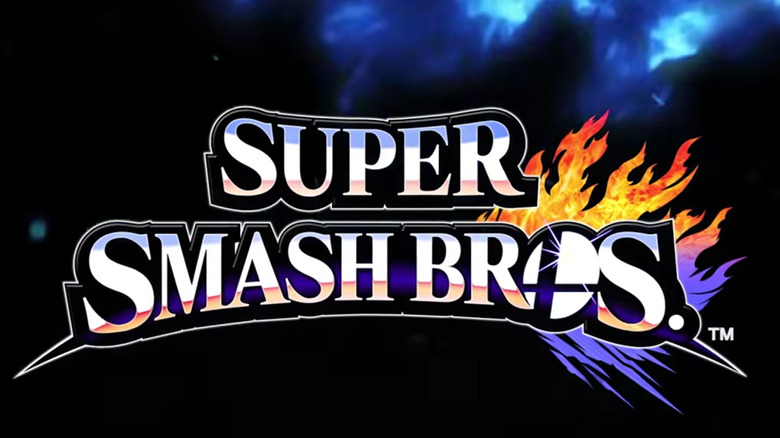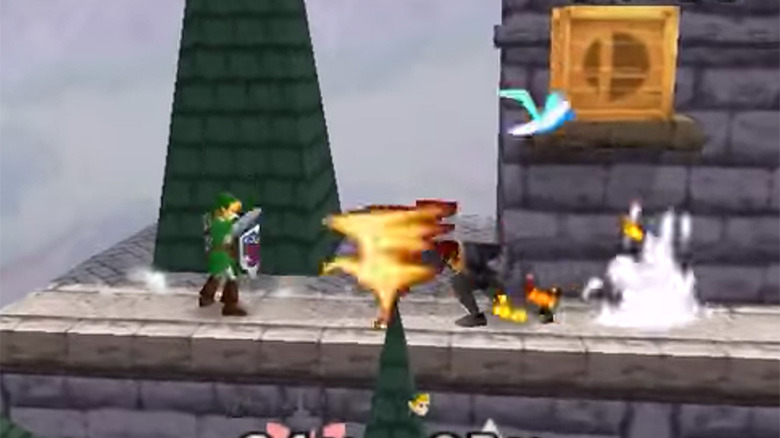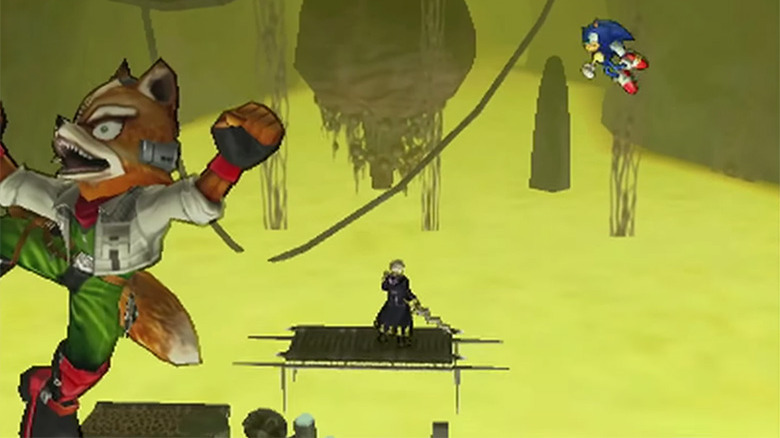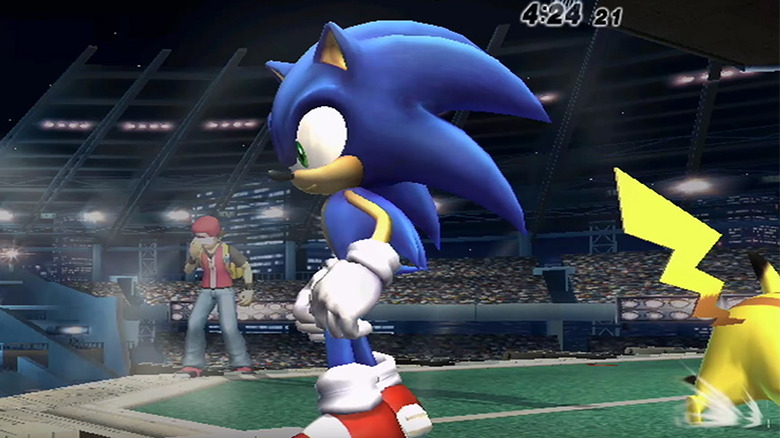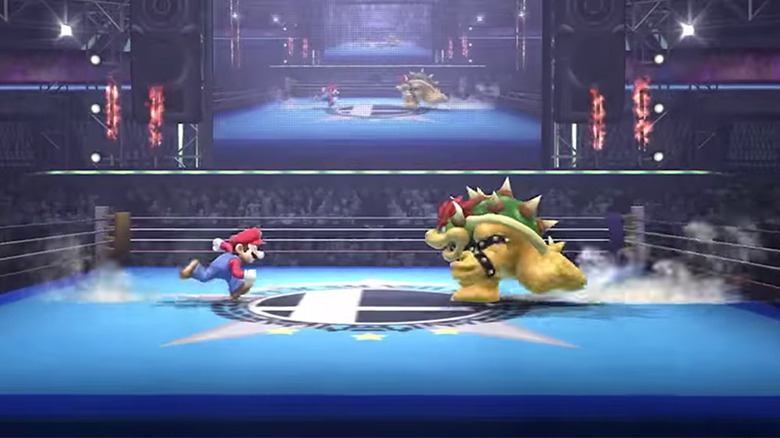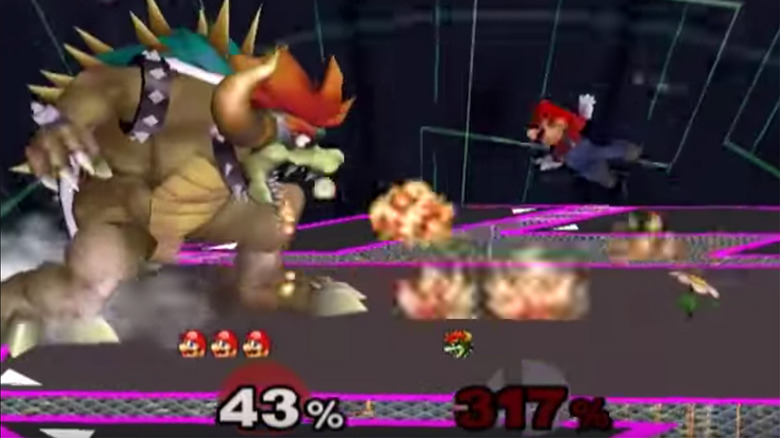The Super Smash Bros. Games Ranked Worst To Best
With simple controls, an innovative hit point system, dynamic stages, and a roster of characters that everyone already loved from all the other games they've starred in, Super Smash Bros. is easily one of the greatest fighting game franchises of all time. Since its debut in 1999, its lighthearted sensibilities and cartoony styles have carved out a place in tournaments alongside bone-shattering arcade stalwarts like Street Fighter and Mortal Kombat, and given plenty of more casual gamers hours of fast-paced fun, too.
That they're great games is pretty undisputable, but the question of which one's best and which one's worst is going to require a closer look. Does an expanded roster balance out slightly wonky controls? Are expansive stages and a single-player campaign better than all-out smashing action? It's a tough call, but we've set up our own version of Final Destination (No Items, Fox Only) to see which Smash title reigns supreme. Here they are, ranked from worst to best!
Super Smash Bros. (Nintendo 64)
It's worth saying right up front that there's never been a "bad" Smash Bros. game. At their very worst, they're still incredibly accessible, fun to play, and full of great ideas, so there's no shame in being at the bottom of this particular list. That said, there's no question that the original Smash Bros. is by far the worst.
It did, however, set the tone for everything that came after, from the over-the-top bellowing announcer to the weird meta-game idea that this was all taking place in some Nintendo-loving kid's imagination. Most importantly, it laid out the structure of the gameplay that would be a strong foundation for the next two decades of gaming. There's a lot to recommend it even without looking at its legacy, too, including some fantastic — if small — stage designs. Even years after Pokéballs were added, it's still pretty fun to fight it out on the Saffron City stage to see which Pokémon are going to pop out of the Silph Co.'s offices.
For all its great groundwork, though, it's a game that definitely has its share of flaws. The limited roster is to be expected from a first game in a franchise, even as late as 1999, but the rough polygon graphics are miles behind the smooth crisp fighters we'd see in even the very next version of the game. Throw in some genuinely terrible box art for good measure, and it's definitely the one that we least want to go back to.
Super Smash Bros. For Nintendo 3DS
Depending on where you put the emphasis, here's a sentence that marks the best and worst of the 3DS Smash Bros.: it's the only Smash Bros. game you can take with you on a plane.
Emphasize the part where you can take it with you, and it's obvious why you'd want to pick this one up. It has the same expansive roster as its Wii U cousin, and for a game that's often marked by sprawling, multi-level stages, it does a pretty good job of keeping everything visible even when you're zoomed out. If Nintendo needed a proof of concept to show that people were definitely going to want a next-gen Smash Bros. that took advantage of the Switch as a portable but full-powered console, then here it is.
But the other part of that sentence is true as well: it's the best portable Smash Bros. because it's the only portable Smash Bros. That means that for now, you'll have to grit your teeth through the laggy multiplayer, which adds a heaping helping of frustration to what's arguably the single most important factor in the franchise's success. On top of that, while the 3DS was a perfectly well-designed console for flagship titles like Pokémon or Zelda, the frenetic pace and control-stick "smashing" made it feel like you were going to snap the handheld console into pieces — possibly because you actually were. It's fine and fun, but it's the definition of "eh, this'll do for now."
Super Smash Bros. Brawl
It's very difficult to imagine a game for the Wii that was as highly anticipated as Smash Bros. Brawl. Not only was it following up one of the best games of the previous generation, not only did it promise a full-on single-player campaign that would go deeper than just a series of arcade-style fights, it packed a roster that was downright shocking. If Sonic being announced allowed players to re-enact the console wars of the '90s and settle the score once and for all, then getting Solid Snake in there was truly mind-boggling. Throw in the Pokémon Trainer and his three different partners, plus the devastating and visually impressive Final Smashes, and it was a game full of surprises that went way beyond what everyone was expecting.
The only problem is that it came out after we'd all had seven years to fall in love with its predecessor. The simplicity of Melee was replaced by a truly bizarre sticker-based customization system, and some of the many subtle changes made to rebalance the game left hardcore Smash players cold. It might not come up a lot in the living room, but for more serious competitors, the game was full of exploits that could leave players locked in place indefinitely, to the point that there was even a fan-made attempt to re-rebalance Brawl to make it more fun. Even that project, though, was based on the idea that for all its flaws, Brawl was still a good game.
Super Smash Bros. For Wii U
If Brawl was the Smash game that opened up the roster beyond Nintendo's first-party characters, the Wii U installment was the game that decided all bets were off. Mega Man and Pac-Man, the most iconic video game character whose name doesn't include the word "Mario," were natural fits. Cloud Strife, on the other hand, was an even more surprising import from the PlayStation than Solid Snake had been, and Bayonetta? She's a witch who shoots angels with guns tied to her feet while pole-dancing. Even if she was just DLC, putting her in the same game as Pikachu was a truly wild choice.
It was also great. All told, Smash 4's roster boasted a full 58 characters, from fan-favorites to obscure weirdos, with 55 stages that boasted the most dynamic environments that any Smash game has to offer. Plus, playing on the WiiU's gamepad had most of the benefits of playing on the 3DS — minus being able to drag it on an airplane, of course — without the feeling that it was going to shatter in your hands if you got a little too overzealous while beating up MewTwo.
It's a shame that a game this good was released on one of Nintendo's worst-received consoles. Then again, since the Switch refined a lot of the Wii U's innovations and ideas and refined them into something better, here's hoping that the inevitable Switch version of SSB does the same with its most recent predecessor.
Super Smash Bros. Melee
The later games in the series may have had more characters, flashier stages, and better graphics, but for the pure fun of sitting down, picking up a controller, and smashing it out, nothing beats Melee.
Part of that comes from the roster of stages, items, and characters that all manage to have their own unique feel even when they're sharing the same movesets, but another part of it comes down to the way it feels, in a very physical sense. The Gamecube controller, for all its many shortcomings, was perfect for Smash Bros., because that's what the game was designed around. It was less awkward than waving around the nunchuk controller on the Wii, and far less fragile than the hand-cramping 3DS, with the ability to fire off a quick smash attack with a flick of the C-Stick or easily air dodge around an attack. With that controller, the game felt natural, which played into the accessibility that's always been the greatest strength of the franchise.
It also represents an incredible leap in quality past its predecessor that hasn't been matched in the years since its release. The gap between the original SSB and Melee, from the blocky polygons of the N64 to the incredible detail in stages like Onett — like the baseball diamond tucked away just off-camera — is wider than the gap between Melee and Smash 4. Even today, it still holds up, and set the standard for everything that came after. There's a reason that this is the game still played at eSports tournaments today, over fifteen years after its original release.

